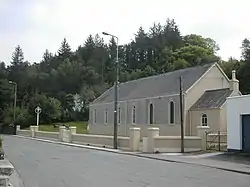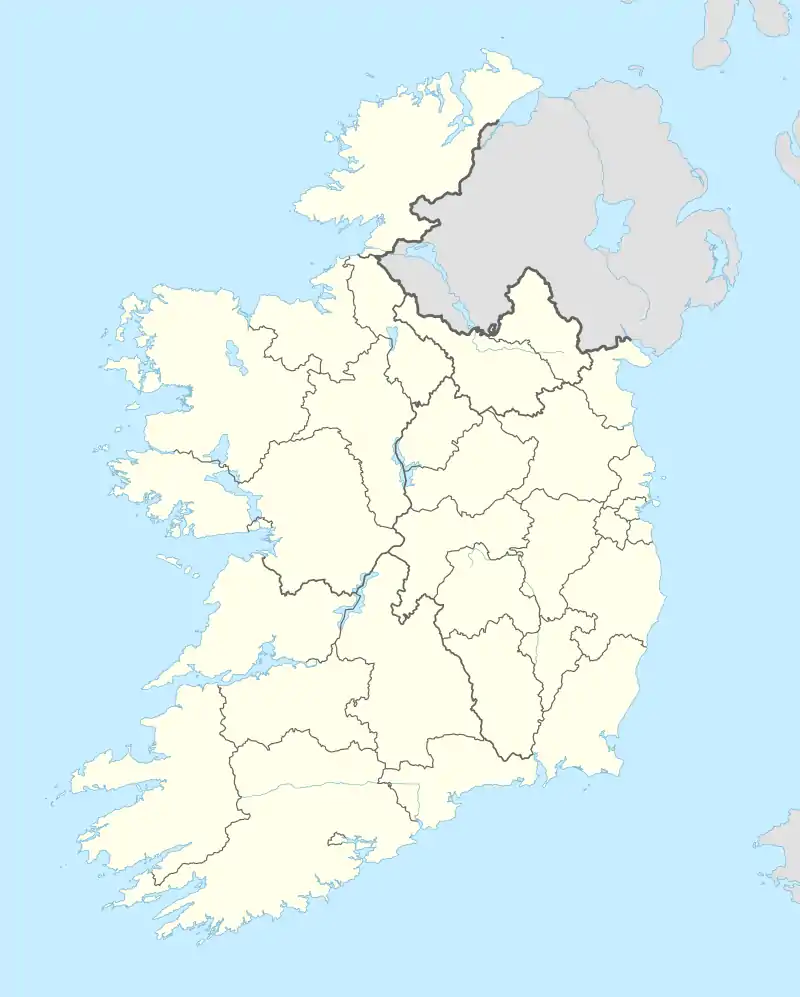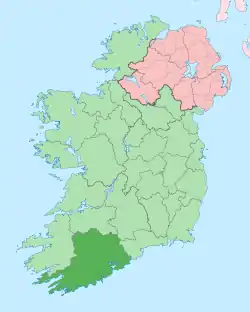Cúil Aodha
Cúil Aodha (pronounced [ˈkuːlʲ ˈeː]), anglicised as Coolea,[1] is a townland and village in the Gaeltacht region of Muskerry in County Cork, Ireland. It is near the River Sullane's source, high in the Derrynasaggart Mountains.
Cúil Aodha
Coolea | |
|---|---|
Village | |
 Church in Cúil Aodha | |
 Cúil Aodha Location in Ireland | |
| Coordinates: 51°55′41″N 09°13′07″W | |
| Country | Ireland |
| Province | Munster |
| County | County Cork |
| Cúil Aodha is the only official name. | |
Geography
The townland of Cúil Aodha is in Ballyvourney parish, and is an official Gaeltacht where the Irish language is used alongside English. The area is known for its strong cultural tradition, especially within in music and song; Sean-nós. The village of Cúil Aodha is close to a number of wind farms which are located on the mountains which mark the border between County Cork and County Kerry. The land is mountainous and roadways are usually narrow lane ways which lead up the valley.
Cúil Aodha lies within the Cork North-West Dáil constituency.[2]
According to the 2016 census, of the 216 people living in Cúil Aodha and the small area surrounding it 86% were able to speak Irish.[3] While in the Gort na Tiobratan electoral division in which the village is located 45% of that population (353) claimed to speak the language on a daily basis outside the education system.[4]
Economy
Coolea cheese is produced in the area. The Mark Éire factory, which specialises in climate technology, opened in 1987 and is still manages its Irish operations from Cúil Aodha village.[5] There are no amenities such as bars, shops or restaurants in the village. These can be found in nearby Ballyvourney.
Film
Both Song for a Raggy Boy (2003), directed by Aisling Walsh, and The Wind That Shakes the Barley (2006), directed by Ken Loach, were filmed in the area surrounding Cúil Aodha.
People

The Irish composer Seán Ó Riada lived in the area between Cúil Aodha village and Ballyvourney until his death. His son Peadar Ó Riada still conducts the choir 'Cór Chúl Aodha'.[6] In the summer of 2008, a bronze monument of Seán Ó Riada was erected near Cúil Aodha.[7] In sport, Donal Óg Ó Liathain from the area played for the Cork inter-county football team.
Transport
The area is rural and has a dispersed population around the valley. No bus service operates to the village. The nearest Bus Éireann route is the Cork to Tralee route which passes through Ballyvourney which is approximately 2 miles from Cúil Aodha village.
References
| Wikimedia Commons has media related to Coolea. |
- "Cúil Aodha / Coolea". logainm.ie. Placenames Database of Ireland. Retrieved 4 February 2021.
- "Map D. Cork - Recommended Dáil constituencies". Constituency Commission Report 2017, Houses of the Oireachtas. Retrieved 4 February 2021
- "ArcGIS Web Application". airomaps.nuim.ie. Retrieved 1 January 2021.
- "ArcGIS Web Application". census.cso.ie. Retrieved 1 January 2021.
- "Mark Éire - Contact". Mark Climate Technology. Retrieved 3 April 2011.
- Long, Siobhan (14 December 2012). "Cór Cúil Aodha and Peadar Ó Riada". Irish Times. Retrieved 1 February 2021.
- Ó Canainn, Tomás (2003). Seán Ó Riada: His Life and Work. Collins Press. p. 143.
